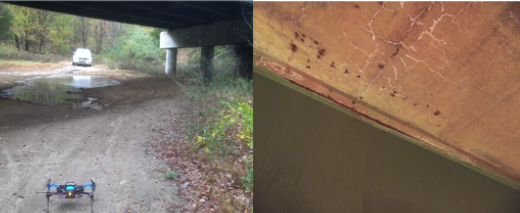
Project 1.18: Vision-Based Detection of Bridge Damage Captured by Unmanned Aerial Vehicles
Vision-Based Detection of Bridge Damage Captured by Unmanned Aerial Vehicles
Project 1.18
Project Summary
Bridge inspection is a vital component of any bridge management strategy of a state DOT. Significant funds are allocated to keeping the over 600,000 bridges in the U.S. safe. A routine bridge inspection is the most common type of inspection and is often performed from deck, ground or water levels or from permanent access structures, if available. Visual inspection is the predominant approach used in a routine inspection. With visual inspection, only basic tools for cleaning, probing, sounding, measuring, and visual aids are used. However, according to research, there can be significant variation in the condition ratings assigned to a structure simply based on visual inspection. The use of unmanned aerial vehicles (UAVs) has recently been explored for the use of bridge inspections. UAVs equipped with high resolution or infrared cameras can be used to scan a bridge taking hundreds of images and essentially building a navigable 3D model of the bridge. Recent advances in machine learning may be employed to automatically identify different types of bridge damage. This research project will evaluate the effectiveness of using more autonomous methods for the collection and analysis of bridge deck images for the purpose of identifying the type and extent of damage in concrete decks.
Project 1.18 Final Report
Principal Investigator:
Dr. Paolo Stegagno
Co-PIs
Dr. Mayrai Gindy
Dr. Abdeltawab Hendawi
Dr. Stephen Licht
Institution:
University of Rhode Island
Project:
Complete
Start Date:
09/01/2022
End Date:
06/30/2024
Project Cost:
$351,596
Project Type:
Base-funded
Agency ID:
69A3551847101
Sponsors:
Office of the Assistant Secretary for Research and Technology, University Transportation Centers Program, University of Rhode Island, Department of Transportation, RIDOT, Steete Engineering.
Implementation of Research Outcomes:
This project is in its initial research phase. Implementation of research outcomes will be reported upon completion of the research outputs.
Impacts and Benefits of Implementation:
This project is in its research phase. Impacts and benefits of the research will be reported after the implementation phase.
